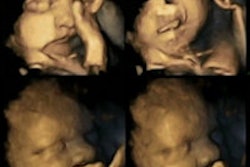Morbidly obese pregnant women face a greater risk of poor outcomes and can be difficult to image adequately on prenatal ultrasound. For that reason, fetal anatomy ultrasound scans should be performed earlier in these women, with the optimal gestational age for scans dropping as body mass index (BMI) goes up.
In a retrospective study that matched fetal ultrasound exams of morbidly obese women with controls of normal weight, a team led by Dr. Christine Lee Ruehl of St. Francis Hospital in Columbus, GA, found that the posterior head and all views of the fetal spine were at risk of suboptimal visualization in women with a high BMI. Based on the analysis, the group developed recommendations for the best gestational age at which scans should be performed according to BMI.
Women with higher BMI should be scanned earlier in pregnancy, as they required an earlier gestational age for an optimal scan, the researchers concluded. Ruehl presented the findings and recommendations during a scientific session at the recent American Institute of Ultrasound in Medicine (AIUM) meeting.
Ultrasound can have limitations in morbidly obese patients (defined as BMI of at least 40), offering additional challenges in patient management, according to Ruehl.
"Maternal morbid obesity yields an unfortunate dyad involving a population at increased risk of fetal malformations and a concurrent decreased ability to detect the problems prenatally," she said.
The researchers sought to evaluate the effects of morbid obesity on 22 standard components of a typical second-trimester ultrasound examination of fetal anatomy. In addition, they wanted to determine which structures are at risk for suboptimal visualization, along with the optimal gestational age at which to perform these exams in morbidly obese patients.
"From a clinical standpoint, the question we wanted to answer was, at what gestational age [should we] schedule our morbidly obese patients for a fetal anatomy scan," she said.
They performed a retrospective chart review of 183 morbidly obese patients from the same tertiary care center. The 183 cases were each matched with controls of normal weight. By comparing the cases, the researchers found that seven structures were at high risk of poor visualization in morbidly obese patients: the cerebellum, choroid plexus, cisterna magna, cervical spine, thoracic spine, lumbar spine, and sacral spine.
Ruehl and colleagues recommended the following timing for anatomic ultrasound:
- 40-44 kg/m2 BMI, 20 weeks' gestational age
- 45-49 kg/m2 BMI, 21 weeks' gestational age
- 50-54 kg/m2 BMI, 18 weeks' gestational age
- 55-59 kg/m2 BMI, 18 weeks' gestational age
- 60-69 kg/m2 BMI, 17 weeks' gestational age
- ≥ 70 kg/m2 BMI, 16 weeks' gestational age
"It was surprising to us that the highest BMI classes necessitated the earliest gestational age for optimal visualization," she said. "We feel this is because at that point in the pregnancy, it's possible for the scan to be performed suprapubically underneath the mom's pannus in order to increase visualization of the fetus."




















